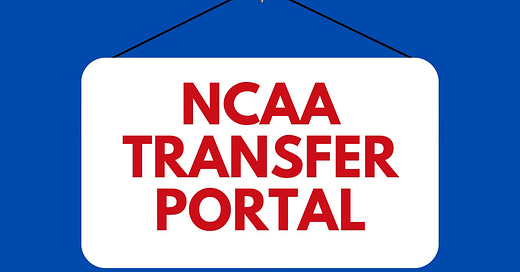As the nation buzzes with excitement over March Madness, another frenzy is unfolding behind the scenes: the NCAA Transfer Portal Madness. Just a day after its opening on Monday, the portal witnessed a whirlwind of activity, with the list of student-athletes surpassing the 100 mark in less than 24 hours. That momentum only intensified as the week progressed, with the number of transfers skyrocketing.
This surge in transfers has sparked fervent conversations and rampant speculation across the collegiate sports landscape. With each new entry into the portal, fans anticipate the potential impact on their favorite teams and programs. Will a recruit find a new home? Could a star player's departure reshape the dynamics of a powerhouse team? The possibilities are endless, adding an extra layer of intrigue to the already exhilarating tournament season.
Behind every transfer decision lies a unique story, a complex interplay of factors that drive student-athletes to seek new opportunities. Some may be motivated by a desire for increased playing time or a better fit within a different program. Others may seek to pursue academic interests or personal growth beyond the confines of their current institution. Whatever the reasons, the transfer portal offers a platform for student-athletes to explore their options and chart their own paths. But amidst the excitement of Portal Madness, it's essential to remember that each transfer represents more than just a strategic move on a roster. Behind every name on the list lies a student-athlete grappling with important decisions about their future—academically, athletically, and personally.
A Game-Changer with Caveats
The NCAA Transfer Portal was created to streamline the process of transferring between NCAA member institutions for student-athletes. Yet, this newfound freedom has its pitfalls. The ease of entering the transfer portal has fostered unrealistic expectations among some athletes and their families. There's a misconception that transferring guarantees better playing time, increased exposure, or improved success— an oversimplification that overlooks the process's complexities and consequences.
Before the portal's inception, transferring was a complex and bureaucratic process. This often involved paperwork, waivers, and uncertainty regarding eligibility. While the NCAA Transfer Portal has indeed revolutionized the transfer process - granting student-athletes the autonomy and flexibility in navigating their collegiate careers, it has also created a culture where parents and athletes perceive the grass to be greener on the other side.
Ease to better or worst
The ease of entering the NCAA Transfer Portal and exploring new opportunities has undoubtedly simplified the process for student-athletes. Yet, this convenience has inadvertently fueled unrealistic expectations among some athletes and their families. There's a prevalent misconception that transferring automatically translates to better playing time, increased exposure, or improved chances of success. However, such assumptions often overlook the complexities and potential consequences associated with this decision.
As the Athlete’s Advocate, it's imperative that we highlight the importance of making informed decisions when considering transferring. While the transfer portal offers a gateway to potential improvements, it's crucial to approach this decision with careful consideration and a clear understanding of its ramifications.
Academic Impact
One of the primary concerns when contemplating a transfer is the academic impact. It's vital to assess whether your credits will transfer seamlessly to the new institution and if you'll maintain eligibility to compete. Additionally, consider whether the prospective institution offers your desired major or academic programs that align with your long-term goals. Transferring may also disrupt your academic progress, necessitating adjustments to your course requirements and academic timeline.
Athletic Impact
On the athletic front, transferring raises questions about whether the move will genuinely enhance your situation. It's essential to evaluate whether the potential benefits outweigh the risks and uncertainties. Consider whether the opportunities available at the new institution align with your athletic aspirations and if the unknown is genuinely preferable to your current circumstances. Moreover, it's crucial to prepare yourself mentally for the possibility of not being recruited by the schools on your list within the Portal.
Personal and Social Impact
Beyond academics and athletics, transferring also carries personal and social implications. Moving to a new institution means leaving behind familiar faces—teammates, coaches, and a support system you've grown accustomed to. Reflect on how this transition will impact your relationships and overall well-being. Are you prepared to adapt to a new environment, forge new connections, and navigate the challenges that come with acclimating to a different setting?
Your life, Your Decision
While the NCAA Transfer Portal offers a promising avenue for student-athletes seeking new opportunities, It's crucial to weigh the potential benefits against the risks and consider the long-term implications on academic, athletic, and personal fronts. Empower yourself with knowledge, seek guidance from trusted mentors and advisors, and carefully weigh the potential impacts before making a decision. Remember, true success stems from informed choices and thoughtful consideration of both the opportunities and challenges that lie ahead.




